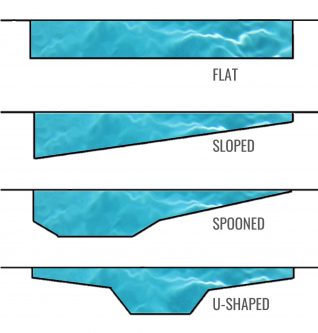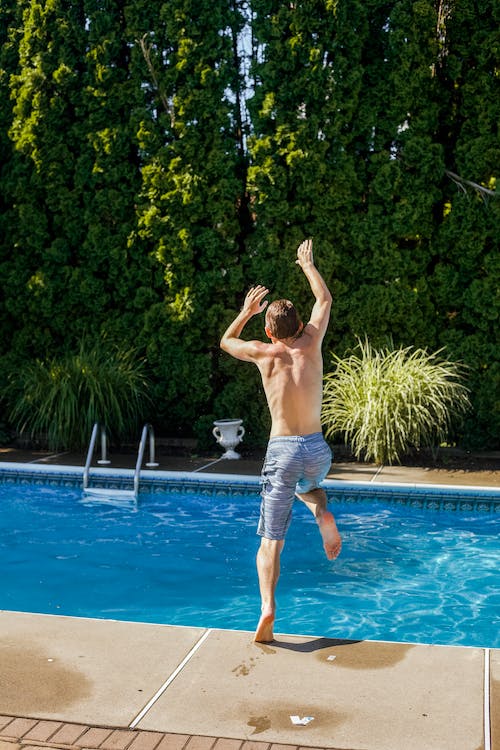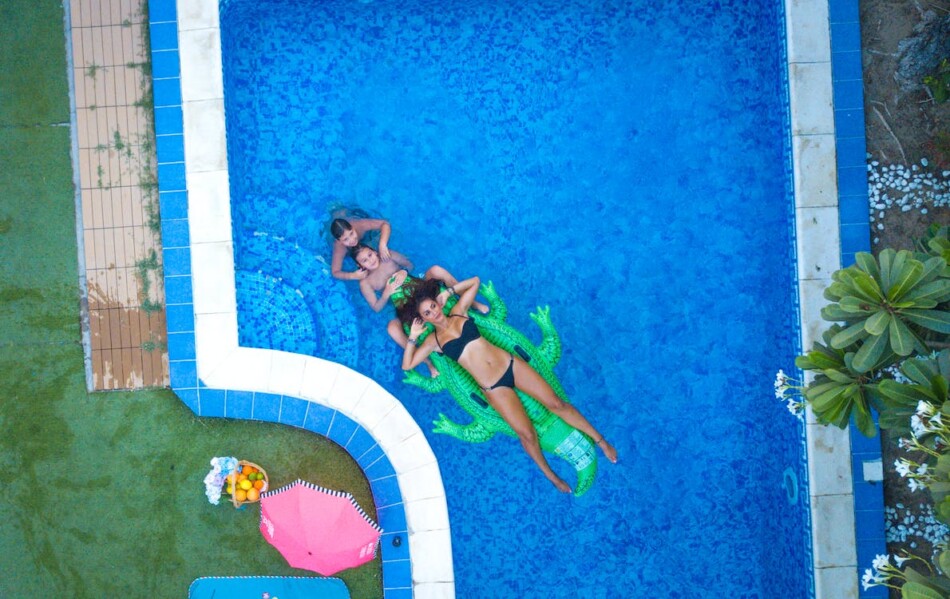Pool Depths and “What Depth of Pool is Best?” is a giant topic to cover but I’m going to do my best in this article to hopefully cover all of the questions you might have. At the end of the day, best will always be a subjective term but there are best-case uses when it comes to depth.
When we talk about pool depths we must consider the slope between shallow and deep which will have a large influence on the best shape and size for your pool as well depending on its use.
In general, the best pool depth is 4 feet and this is what a majority of your pool depth should be and is considered the shallow end of most pools. The best pool depth for your deep end is 6 feet deep in a recreational pool. Recreational pools are shallower in comparison to what we call a diving pool. At a majority of 4 feet, deep this allows for many water games and recreational activities like lounging, and it keeps water from going over most adults’ heads. The deep end of 6ft will allow for safe feet first jumping without the risk of hitting the bottom of the pool.
This is my opinion on what depth of pool is best from my own personal experience, interviewing pool builders, and scouring online groups for additional information and opinions. This doesn’t mean it’s the best for you necessarily, so let’s cannonball our way into a ton of more information to help you decide on what is the best pool depth for your pool.
How Deep is the Average Inground Pool?
25 years ago the average inground pool was 3.5 feet to 8-9 feet deep. This is because homes had much larger backyards then and the maintenance cost for pool chemicals and annual upkeep wasn’t as expensive as it is today. The average inground pool depth in 2023 is 3.5 feet to 5 feet deep. Homes are built much closer together today which reduces the size of the backyard and in general, the size of most pools built and sold in 2023. There is also the introduction of Fiberglass inground pools which until recently didn’t have many models that allowed for diving which requires a minimum of 8ft. which would reduce the average depth with their rise in popularity.
How Deep is the Average Above Ground Pool?

I know not everyone reading this is interested in the costs of an inground pool so I wanted to give some information about above-ground pools as well. The average above-ground pool is 4 feet deep and it typically has a flat bottom. We will get into that a little bit later in this article. When you look to buy these pools online, the most common size options are 48″-54″ and generally, the pool water will sit 6″ below that. As discussed though, this is a great depth for a recreational pool and I don’t think you can really go wrong with a decent size 4 feet deep above-ground pool if you aren’t willing to commit long-term to an inground pool.
Are Varied Pool Depths Possible?
Not only are they possible, but they are also the most common pool depths built for inground pools. Rare for above-ground pools though. Let’s discuss your different pool bottoms since we are going to discuss varied depths.
Flat – This is a consistent size throughout the entire pool. For example, 4ft deep throughout the entire pool like in above-ground pools.
Sloped – A gradual consistent slope that increases in Depth from the shallow to the deep end until you reach the deepest part of your pool. For Example, 3.5 ft Shallow to 8 ft deep in a Diving Pool.
Spooned – Like sloped, this is an increase from Shallow to Deep but the slope is not consistent and in some places not gradual but rather sharp. For Example, in a 3.5 ft shallow end that increases to 5 ft depth in the middle of the pool with a steep floor drop.
U-Shaped – Shallow to Deep to Shallow again giving your pool two shallow ends with a deep end in the middle. The slope isn’t very gradual and is steep so that smaller-sized pools can quickly reach their maximum depth in the middle of the pool. For example, 4 ft – 6 ft – 4 ft. these are called Sports Pools.

Each one of these pool depths is suitable for different use cases for pool use or may be necessary due to space restrictions with the overall size of the pool. For example, the spooned bottom with such a drastic drop to the deepest part of the pool isn’t ideal. But if you are limited in space but want to get 6 ft or deeper to accommodate jumping from jump rocks, it may be necessary.
Defining Pool Type by Depth
Diving Pools and Recreational Pools are the two types of pools defined by pool depth. Why is that? Because if you want a diving pool you must go to a minimum of 8 ft deep to accommodate the diving. We want to start with this binary decision-making on the type of pool by depth so it can help to eliminate what we do or don’t want from our decision-making. If you are going to get to 8 feet deep with a sloped pool you’ll need a lot of space, but if limited on space then you might be looking at a spooned bottom. As you can see, this is an important part of decision-making. A diving pool will also reduce the amount of shallow area in your pool unless you are building a massive pool of over 1000 sq. ft.
A recreational pool, which I consider to be the best pool depth range, is a pool that consists of a majority of shallow areas at 4ft. Adding some size to the pool, you can still have a gradual slope that will get your recreational pool to 6ft deep at the deep end without the need for huge drop-offs. This provides ample space for playing games in the shallow area of the pool while allowing for some jumping in the deeper end without the fear of hitting the bottom of the pool.
If you are divided on what is better for you, a diving pool or a recreational pool, then let’s jump into the factors that will help you make that decision. You can also check out our complete guide on inground pool sizes to help you determine which pool size is best for you.
Who Will Be Swimming in your Pool?
This isn’t just a question for now but also a question for 5 and 10 years from now. Kids don’t stay little, as much as we wish they would, they will grow up into teenagers and young adults with kids of their own at some point. How will our pool still be attractive to those different age groups as they get older? Kids, of course, love jumping and diving into the pool but would they still enjoy that as much as teenagers, or are they going to be more interested in lounging with friends and playing a game of volleyball in the middle of the pool? I believe the latter is true in this case.
Swimming ability and safety are also a concern to consider. Can Grandma swim? Is she afraid of water? If so, we can assume she isn’t going to be diving off the board into the deep end anytime soon. She would probably prefer keeping her head above the water and lounging in the 4 ft shallow area of the pool. In cases like this, a recreational pool would be the best choice especially if you plan to have a large range of varied groups from experienced to inexperienced swimmers enjoying your pool. These shallower depths will give you more usable space in the pool instead of a large deep end for diving that might go unused a majority of the time.

What is the Purpose of your Pool? Little Johny’s Case Study
Honestly, this is a continuation of who will be using your pool. We know the who, but we want to know the What. What will little Johny and his friends want to do in the pool now, 5 years from now, and 10 years from now? Let’s take an 8-year-old boy, for example. Right now, he wants to get in and out of the pool so he can cannonball into the deep end over and over again all day long. I think that’s great, and the perfect depth for me, in that case, will be a 6 ft deep pool with a jumping rock for Johny. 4 ft depth can work as well but not for everyone and I would want a little bit deeper just in case Johny decides to do a head-first dive even though we warned him not to do it.
Jump into the future 5 years from now, Johny is 13 years old. He isn’t as interested in jumping into the pool these days. He wants to have his friends over and have a challenging game of volleyball or basketball. If you built the diving pool 5 years ago with the 8 ft. deep end, the shallow space is most likely limited so one of the volleyball teams is going to be fighting to keep their head above water while they play. In a recreational pool, this won’t be an issue and everyone will be above water with the large amount of 4 ft deep shallow space in the pool. This is something to consider for your pool purchase or build.
Fast forward 5 more years, Johny is 18 years old, and honestly, he is probably still doing the same thing but he is just a bit taller now. He might be interested in doing some diving but will probably spend most of his time on the shallow end of the pool playing games and maybe just lounging.
I think this type of planning for future pool use is an important step in making the right decision for your pool depth. Consider the family and friends who will be in your pool the most and what they would want to do.
What Activities Can You Do in Deep Pools?
As mentioned, these pools are referred to as diving pools because the main reason for building a deep pool is to install a diving board or diving platform to jump head-first into the pool. Other than that, you could tread water, which is absolutely fun, I personally really enjoy it as it keeps me active while still chilling in one spot. There are typically benches built into the deep area of the pool as well.
You can build jumping rocks and slides into a deep area of a pool like this but it isn’t actually required and they can be built onto shallower depths like 6ft.
What Activities Can You Do in Shallow Pools?
A ton! You can do all of the activities in the shallow end of the pool except for head-first diving. Even jumping depends on exactly how deep you have made your pool. But, this is where people lounge around and hang out with minimal effort. Kids are playing games in the shallow end like chicken, basketball, macro polo, and volleyball. The number one bit of feedback we do hear from our customers is that they wished they had built more shallow end for their pool for this exact reason.
Closing Thoughts on the Perfect Pool Depth
Pools are definitely not one size fits all. That’s why concrete pools remain the number one built pool in the world, people absolutely love customization for their pools. My personal recommendation would be to look at a sports pool with a 6 ft. deep end in the middle of the pool or a traditional style pool with the slope bottom into a 7 ft deep end that includes a nice set of jumping rocks. I would build 7 ft just to give some extra room in case someone ignores our rules and tries to dive head-first. Both pools would have large amounts of 4 ft space as the shallow end to allow for volleyball and basketball.

